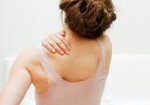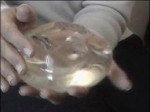 Breasts—especially those that scale towards the large end of the spectrum—are often named as a scapegoat for back pain in women. However, it’s likely that much of the blame is misplaced. This misdirected implication could be leading women to false self-diagnoses and even unnecessary medical procedures.
Breasts—especially those that scale towards the large end of the spectrum—are often named as a scapegoat for back pain in women. However, it’s likely that much of the blame is misplaced. This misdirected implication could be leading women to false self-diagnoses and even unnecessary medical procedures.
Many women experience back pain and, without a more apparent culprit to blame, turn to those (literally) right under their noses. It’s not surprising that people want to point the finger at breasts as back pain contributors. After all, it seems intuitive to think that bulky weights attached to the upper torso would throw the entire body off balance and put extra stress on the spine and muscles that support it. When considering that these weights are present through every moment of every day of your life, and suddenly this seems like a very logical diagnosis.
In reality, though, breasts are rarely the primary contributor to most varieties of back pain. The human back, when healthy and normal, is more than strong enough to support even a fairly large chest through the years. Instead, there are many more common factors that cause back pain in women such as
- Obesity that causes undue and constant stress to the entire body
- Pregnancy and the related physiological changes
- Non-optimal bra size
- Chronic poor posture
- Injury or overexertion of the muscles or bones in the back
- Irritation of spinal nerves through disc herniation or bulging
- A weakening of the spine through osteoporosis and similar conditions
Compared to these pain originators, breasts are much less likely to cause a painful condition themselves. However, they can exacerbate an existing condition. Breasts can make bad posture worse, will add additional stress to pulled muscles, and make it harder for injured discs to heal.
There are some steps women can take to avoid or remedy back pain that could be contributed to by the weight of breasts. The most important is to keep as healthy of a body overall as possible through diet and exercise. This will help ensure a strong back which will be able to easily support breast weight and more. It will keep weight at a manageable level to reduce excess stress on muscles and joints, and speed healing from any injuries. Care must be taken to avoid overexertion like strains and sprains, which cause pain more directly.
In some cases, it’s possible that a woman’s breasts are a primary cause for her back pain. This happens most frequently when a relatively small person has disproportionately large breasts. A reduction surgery may be recommended by doctors if the breasts are causing chronic pain and compromising the woman’s happiness. Back pain can also occur after a time a rapid breast size increase, like after a breast augmentation surgery. Over time this pain usually fades as the body adjusts to the new size, but a reduction or reversal of the surgery may also be recommended if the pain is persistent.
Women have, understandably, blamed breasts for unexplained back pain. Before jumping to conclusions or turning to extreme treatments, however, they should always be careful to consider more likely culprits than those on their chests first.
Guest Author Jamie Arnold is a staff writer & content editor for www.BackPainRelief.net. Jamie is also a yoga enthusiast, animal lover and avid traveler who loves to blog about health, fitness, and back pain relief.

 The U.S. Food and Drug Administration (FDA) this month
The U.S. Food and Drug Administration (FDA) this month